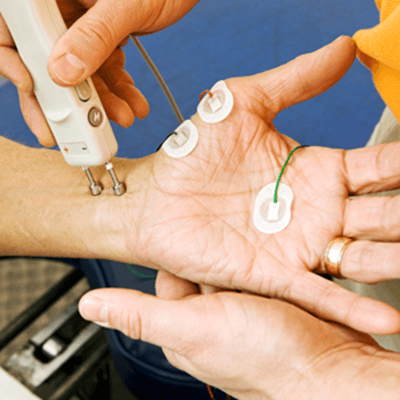What is the full form of EMGEMG: ElectromyogramEMG stands for Electromyogram. It is a diagnostic test which is performed to record the electrical activity of muscles at rest and during contraction. It evaluates the health of muscles and nerve cells that control them. The nerve cells which are called motor neurons send electrical signals (impulses) to muscles that allow muscles to contract. EMG tests how well your muscles respond to electrical signals received from nerve cells (motor neurons). The EMG translates these electrical signals into graphs, numerical values etc that are interpreted by the specialist. In this test, electrodes are used to transmit or detect electrical signals. 
This test has two components: Nerve conduction study and Needle EMG. Nerve conduction study: It is the first part of this test in which electrodes are placed on the skin to measure the movement and strength of impulses moving between two or more points. It evaluates the ability of nerve cells to send electrical impulses to their respective muscles. Needle EMG: In this part of the test, a needle electrode is inserted directly into a muscle to record and evaluate electrical activity of that muscle during contraction and rest. It acts like a microphone inserted into the muscle. A doctor usually suggests EMG when a person shows the symptoms of a muscle or nerve disorder such as:
Its results help doctor diagnose nerve disorders, muscle disorders, and other disorders that affect the coordination between nerve cells and muscles such as:
RisksA low-risk procedure, EMG rarely has problems. Where a needle electrode is implanted, there is a slight possibility of bleeding, infection, and nerve damage. There is a very slight chance that air could seep into the space between the lungs and chest wall during a needle electrode examination of the muscles along the chest wall, leading to the collapse of a lung (pneumothorax). How do you get readyMedicines and food Ask if you need to cease using any prescription or OTC medications prior to the EMG while scheduling the appointment. Ask particularly if any medications, such as Mestinon (pyridostigmine), should be stopped prior to the exam if you're taking them. Bathing Just before your checkup, take a bath or shower to get rid of any oils on your skin. Before the exam, avoid using creams or lotions. Additional safety measuresIf you have any particular medical issues, the neurologist (a specialist in the neurological system) performing the EMG will need to know. Inform the neurosurgeon and other EMG lab staff if you:
What to anticipatePrior to the process The process will probably require you to lie down on an examination table while donning a hospital gown. Depending on where you are experiencing symptoms, the neurologist or a technician will apply surface electrodes to different parts of your skin to prepare for the study. Alternatively, based on your symptoms, the neurologist may place needle electrodes at various locations. Throughout the process The surface electrodes may occasionally transfer a very small electrical current during the course of the research, which you might experience as a twinge or spasm. There may be some discomfort or pain from the needle electrode, but this normally goes away soon after the needle is taken out. The neurologist will evaluate the degree of electrical activity when you slightly contract the muscle during the needle EMG in order to determine whether there is any spontaneous electrical activity while the muscle is at rest, which is an activity that is not present in healthy muscular tissue. You will receive directions from him or her on when to rest and contract a muscle. During the examination, the neurologist may ask you to switch positions depending on the muscles and nerves they are evaluating. You might wish to discuss taking a brief break with the neurologist if you experience any discomfort or pain throughout the test. Following the procedure The area where the needle electrode was put into your muscle may temporarily bleed slightly. This bruise should go away in a few days. Contact your healthcare physician if it continues. ResultsYour exam results will be interpreted by the neurologist, who will also write a report. During a subsequent session, the report will be discussed with you by your primary care physician or the physician who performed the EMG.
Next TopicFull Form
|
 For Videos Join Our Youtube Channel: Join Now
For Videos Join Our Youtube Channel: Join Now
Feedback
- Send your Feedback to [email protected]
Help Others, Please Share










